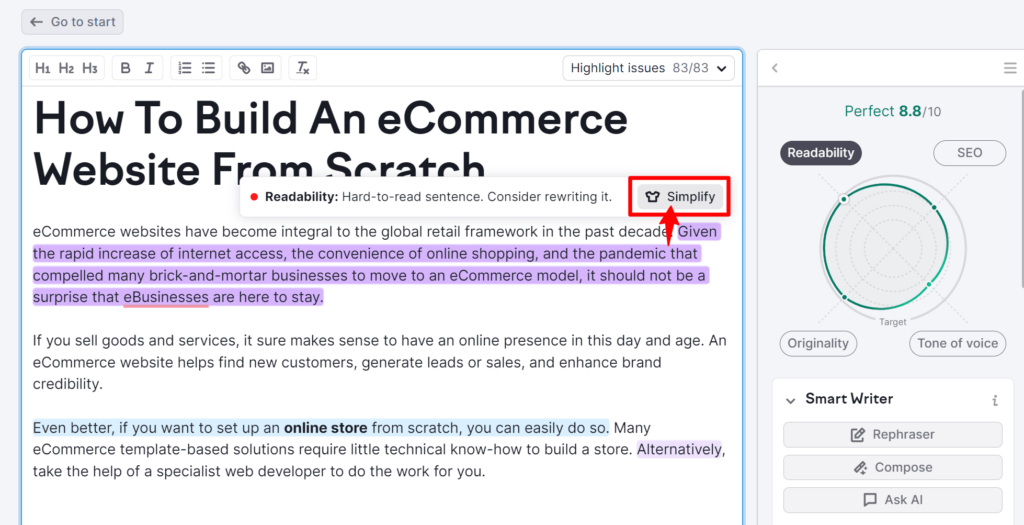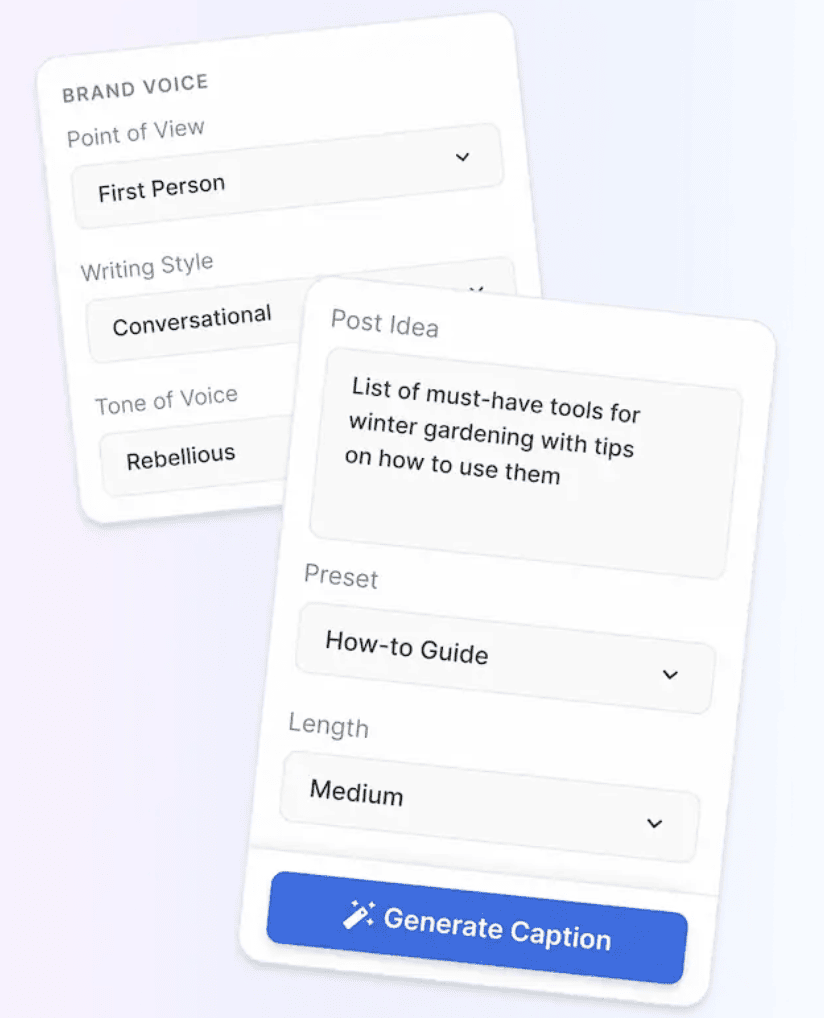OpenAI’s ChatGPT reached 100 million users faster than most apps did, and by February 2023, the website recorded over 25 million daily users.
The introduction of AI has revolutionized how humans work. More and more business owners are using AI-generated content to run ads and marketing campaigns. AI market size is expected to grow to $407 billion by 2027.
As everyone is generating AI content, it’s important to understand how it works, its benefits and shortcomings, and how to use it to grow your business.
In this guide, I’ll take you through the process of generating content with AI and its challenges and advantages. I’ll also explore the expected AI content trends in the future.
- AI content is the content generated by artificial intelligence algorithms and tools.
- AI content platforms use a combination of AI-powered algorithms and large data sets to help you produce content that mimics human-like writing, design, art, and other creative expressions.
- AI-generated content may pose quality, uniqueness, and ethical concerns, among other challenges. But with smart human intervention, it’s easy to use AI to your advantage and improve efficiency.
What is AI Content?
AI content refers to the content created or enhanced using artificial intelligence technologies and tools. This includes content in various media formats like text, image, audio, and video.
AI-powered algorithms and platforms mimic human intelligence by analyzing data, understanding patterns, and creating content that is similar to what a human might create.
Here are the top characteristics of AI-generated content:
- Automated content created by machines: AI content is created by computer programs and machines with minimal human intervention.
- Continuous improvement: AI curates large amounts of data, identifies common patterns, and understands and uses it to generate content similar to your preferences over time.
- Consistency: Through prompts, AI-powered algorithms ensure a uniform style and tone across the content it creates, maintaining your brand identity.
- Flexibility: You can adjust AI-created content by entering prompts related to the changes you need. This could be making the tone more formal or adding relevant emojis to your social ad copy.
- Efficiency and scalability: AI accelerates the process of content generation, analysis, and curation, helping you save time and resources. This also helps you scale your content production quickly and consistently.
- Versatility: AI can generate and enhance various types of content, from text to images, audio, and videos.
- Cost-effectiveness: Using AI content solutions can reduce costs associated with content creation and management.
How Does AI Content Work?
AI content creation involves a combination of algorithms and large data sets to produce content that mimics human-like writing, design, art, and other creative expressions.
An Overview of AI Algorithms Used for Content Generation
Here are the algorithms that generative AI uses for content generation:
- Recurrent Neural Networks (RNNs) and Long Short-Term Memory (LSTM): Used for sequence generation tasks like language modeling and text generation. They can capture long-term dependencies in data.
- Generative Adversarial Networks (GANs): Consists of two neural networks, a generator, and a discriminator. The generator creates content to try and deceive the discriminator into believing it's real and generates high-quality content through this iterative process.
- Transformer-based models: For example, the GPT (Generative Pre-Trained Transformer) series is widely used for Natural Language Processing (NLP) tasks like text generation. Transformers use attention mechanisms to weigh the significance of different words in a sentence, enabling them to capture complex contexts.
- Variational Autoencoders (VAEs): Used to generate new content by learning the connection between the input data and hidden information. They are mostly used in image and video generation.
Natural Language Processing (NLP) and its Role in AI Content Generation
NLP involves understanding and processing human language, allowing AI to comprehend, analyze, and generate text that is coherent and contextually relevant.
NLP models learn to understand the meaning and context of words and phrases in a given sentence. Understanding this helps in creating meaningful content.
The models can learn grammar rules, sentence structures, and writing styles from training data. It then uses this knowledge to generate different styles of content.
AI Data Sources and Training Models
AI content creation requires a significant amount of training data. Data can come from diverse sources, such as books, articles, websites, social media posts, or any text available on the internet.
AI content, such as images and videos, requires labeled datasets specific to the content type.
AI models used for content generation are trained on large datasets using various machine-learning techniques. During training, the model learns patterns, styles, and contextual relationships present in the data.
The training process involves adjusting model parameters to minimize the difference between the generated content and the actual data. After initial training, AI models can be fine-tuned on specific datasets or with domain-specific content to tailor the generated content to a particular style, industry, or purpose.
What Are the Different Types of AI Content?
There are many types of AI-generated content. Each serves specific purposes and caters to different audience preferences.
- Text-based AI content: Text-based is any content that is composed of written text and is generated by AI. It can include articles, blog posts, marketing copy, reports, emails, and any other form of written communication. Consider the type of content you get from Surfer’s Content Editor or Semrush’s SEO Writing Assistant.

- Visual AI content: Visual AI content involves the generation or modification of images, videos, graphics, and any other visual elements using AI algorithms. For instance, image creation, image enhancement, style transfer, image-to-text generation, and more.
- Audio AI content: Audio AI content is the generation or manipulation of audio elements using AI technologies. For instance, speech synthesis, voice modulation, music composition, sound effects generation, audio transcription, and more.
- Multimodal AI content: Multimodal AI content refers to content that integrates multiple forms of media, such as text, images, audio, and videos. AI can generate or enhance content by combining information from various modalities.
For instance, generating video content with accompanying text descriptions or generating image captions based on audio input. You can use AI-powered tools like invideo to do this.
The Benefits of AI-Generated Content
Using AI to generate various content types will save you time and resources. You can ask your team members to focus on more demanding tasks such as building an SEO content strategy or an email marketing funnel.
Here are the benefits of generating AI-powered content:
1. Increased efficiency and productivity
AI content creation enhances efficiency and productivity by automating the content generation process.
Tasks that would traditionally require significant time and effort, such as writing, designing, or formatting content, can now be done using AI.
2. Consistency in content style and tone
AI ensures consistency in the generated content pieces by adhering to prompted patterns, styles, and guidelines. The algorithms can replicate specific writing styles, tone, and formatting consistently across large volumes of content.
Consistency is vital for maintaining a cohesive brand image and delivering a unified experience to the audience.
For example, Flick’s AI assistant lets you create on-brand social content 10x faster. Just enter the right prompts in it to create posts that will entice your followers.

3. Enhanced personalization and audience targeting
AI enables personalized content creation by analyzing user data, preferences, and behaviors. It can tailor content to individual users based on their interactions, browsing history, location, and demographics.
Leveraging personalized content can help you improve user engagement and satisfaction because it’s more relevant and appealing to each user, ultimately leading to higher conversion rates.
4. A boost in scalability and content volume
AI can handle a vast volume of content production in a short amount of time, making it ideal for large-scale projects and campaigns. The ability to scale content production ensures you meet your business’ content demands without compromising on quality.
The Challenges and Limitations of AI-Generated Content
Just as with every innovative technology, AI has its limitations and challenges. Let’s look at a few and how they can impact content creators:
- Quality concerns: AI-generated content may suffer from quality issues, such as grammatical errors, incoherence, or lack of context. Achieving a level of quality comparable to human-created content remains a significant challenge.
- Ethical considerations: The ethical implications of AI content creation are a critical challenge. There are concerns regarding plagiarism, copyright infringement, and the responsible use of AI to create content. In addition, the potential for AI-generated content to spread misinformation or biased narratives raises ethical dilemmas.
- Human-AI collaboration: Striking the right balance between human intervention and AI automation is a challenge. Over-reliance on AI can diminish creativity and human touch, impacting the authenticity and uniqueness of your content. It is crucial to preserve the creative essence of human inputs in AI content.
- Potential for misinformation spread: AI-generated content can produce misleading or false information. Malicious people could misuse AI to create fake news, fake images, or deceptive narratives. Addressing this challenge involves developing advanced detection mechanisms and promoting responsible use of AI to combat misinformation.
The Future Trends in AI Content
The future of AI content promises to transform the way we generate, consume, and interact with digital content. Let’s look at some expected future trends in AI content:
- Advancements in AI technology: AI technology is continuously evolving, and future advancements are expected to revolutionize AI content creation.
Such improvements include more sophisticated natural language processing (NLP) models, enhanced generative algorithms, and improved multimodal capabilities that will enable AI to generate high-quality, diverse content across various mediums. - Improved content quality and human-like writing: Future AI content is anticipated to achieve higher levels of quality, coherence, and creativity, approaching a degree of human-like writing.
AI models will likely become better at understanding nuances, context, and emotions. This will help us create AI content that is more convincing and resonates with readers on a deeper level. - Strengthened ethical guidelines and regulations on AI content: As AI becomes more prevalent in content creation, placing ethical guidelines and regulations specific to AI content will be essential.
These guidelines will focus on ensuring responsible AI use, addressing bias, minimizing misinformation, and upholding copyright and intellectual property rights.
Governments, organizations, and industry groups must collaborate to establish frameworks that guide the ethical development and deployment of AI in content creation. - Increased level of customization and personalization: AI will increasingly personalize content to cater to individual preferences and behaviors.
Advanced algorithms will analyze vast amounts of data to create highly tailored content, leading to better user engagement and satisfaction. From personalized marketing messages to customized news feeds, AI will deliver content that is most relevant to each individual.
Content Creation Will Never Be the Same with AI
Content creation has changed forever with the introduction of different AI technologies.
Leveraging AI can help you speed up your work tasks and create consistent content that maintains your brand voice.
As you begin to explore and use AI, you must remain vigilant and rectify errors or biases it may create. Remember to fact-check your AI content before publishing it because AI content can be misleading sometimes.
You must also use AI responsibly to help build your creativity rather than dimming it.
How are you using AI? Do you use it to write blog posts or create social ad images? Let me know your thoughts with a comment below.


Related Articles
22 Useful Content Promotion Platforms and Tools
21 Awesome Ecommerce Content Marketing Examples for 2024
7 B2B Content Marketing Tactics You Need to Start Using Today
Short Form Vs. Long Form Content: Which is Better?
21 Best Content Writing Tools to Help You Become a Better Writer
11 Best Grammarly Alternatives That a Smart Writer Needs to Know